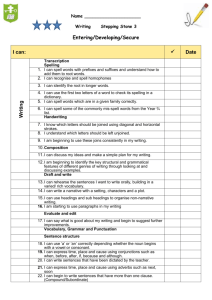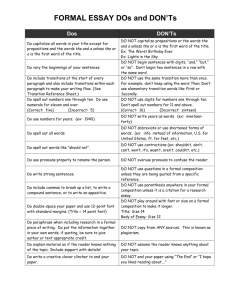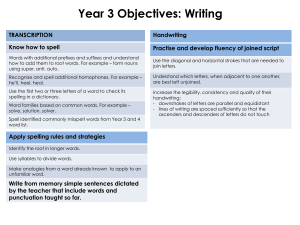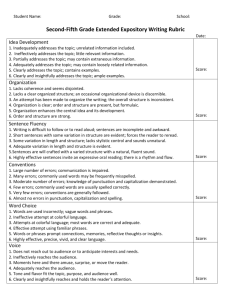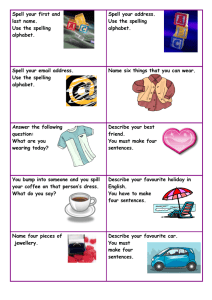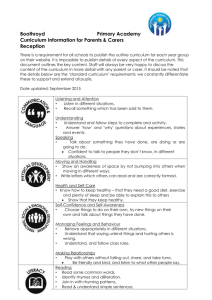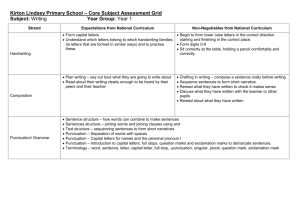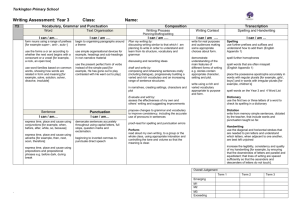The National Literacy Strategy
advertisement
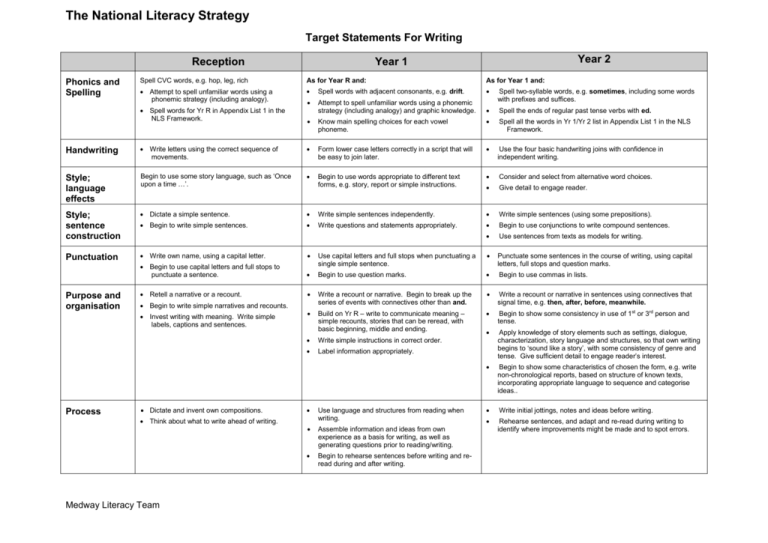
The National Literacy Strategy Target Statements For Writing Reception Phonics and Spelling Year 2 Year 1 Spell CVC words, e.g. hop, leg, rich As for Year R and: As for Year 1 and: Attempt to spell unfamiliar words using a phonemic strategy (including analogy). Spell words with adjacent consonants, e.g. drift. Attempt to spell unfamiliar words using a phonemic strategy (including analogy) and graphic knowledge. Spell two-syllable words, e.g. sometimes, including some words with prefixes and suffices. Spell the ends of regular past tense verbs with ed. Spell words for Yr R in Appendix List 1 in the NLS Framework. Know main spelling choices for each vowel phoneme. Spell all the words in Yr 1/Yr 2 list in Appendix List 1 in the NLS Framework. Handwriting Write letters using the correct sequence of movements. Form lower case letters correctly in a script that will be easy to join later. Use the four basic handwriting joins with confidence in independent writing. Style; language effects Begin to use some story language, such as ‘Once upon a time …’. Begin to use words appropriate to different text forms, e.g. story, report or simple instructions. Consider and select from alternative word choices. Give detail to engage reader. Style; sentence construction Dictate a simple sentence. Write simple sentences independently. Write simple sentences (using some prepositions). Begin to write simple sentences. Write questions and statements appropriately. Begin to use conjunctions to write compound sentences. Use sentences from texts as models for writing. Punctuation Write own name, using a capital letter. Use capital letters and full stops when punctuating a single simple sentence. Begin to use capital letters and full stops to punctuate a sentence. Punctuate some sentences in the course of writing, using capital letters, full stops and question marks. Begin to use question marks. Begin to use commas in lists. Retell a narrative or a recount. Write a recount or narrative. Begin to break up the series of events with connectives other than and. Write a recount or narrative in sentences using connectives that signal time, e.g. then, after, before, meanwhile. Build on Yr R – write to communicate meaning – simple recounts, stories that can be reread, with basic beginning, middle and ending. Begin to show some consistency in use of 1st or 3rd person and tense. Write simple instructions in correct order. Label information appropriately. Apply knowledge of story elements such as settings, dialogue, characterization, story language and structures, so that own writing begins to ‘sound like a story’, with some consistency of genre and tense. Give sufficient detail to engage reader’s interest. Begin to show some characteristics of chosen the form, e.g. write non-chronological reports, based on structure of known texts, incorporating appropriate language to sequence and categorise ideas.. Write initial jottings, notes and ideas before writing. Rehearse sentences, and adapt and re-read during writing to identify where improvements might be made and to spot errors. Purpose and organisation Begin to write simple narratives and recounts. Invest writing with meaning. Write simple labels, captions and sentences. Process Dictate and invent own compositions. Think about what to write ahead of writing. Medway Literacy Team Use language and structures from reading when writing. Assemble information and ideas from own experience as a basis for writing, as well as generating questions prior to reading/writing. Begin to rehearse sentences before writing and reread during and after writing. Year 2 Year 3 Year 4 Phonics and Spelling As for Year 1 and: Spell two-syllable words, e.g. sometimes, including some words with prefixes and suffices. Spell the ends of regular past tense verbs with ed. Spell all the words in Yr 1/Yr 2 list in Appendix List 1 in the NLS Framework. As for Year 2 and: Attempt to spell unfamiliar words using know conventions and rules and a range of strategies including phonemic, morphemic and etymological. Spell words containing common prefixes and suffices, e.g. un-, dis-, -ly, -ful. Use apostrophe for omission, e.g. can’t. Spell inflected forms of words containing short vowels, doubling the final consonant where necessary, e.g. win – winning, beg – begged. As for Year 3 and: Attempt to spell unfamiliar words using known conventions and rules, and a range of strategies including phonemic, morphemic and etymological. Spell the words for Yr 4 in Appendix List 2 in the NLS Framework. Distinguish the spelling of common homophones, e.g. hear and here. Use the dictionary to check spellings of words. Use the apostrophe for omission. Handwriting Use the four basic handwriting joins with confidence in independent writing. Write legibly with a joined hand, maintaining consistency in size and spacing. Use fluent joined handwriting for all writing except where other special forms are required. Style; language effects Consider and select from alternate word choices. Give detail to engage reader. Use interesting vocabulary; vary use of adjectives and verbs for impact. Select nouns to be specific, e.g. poodle rather than dog. Use terminology appropriate to text type. Use adjectives and adverbs selectively to create variety and add interest. Use powerful verbs to show character or add impact. Use language precisely and selectively in relation to text type, for instance to persuade or convey information. Style; sentence construction Write simple sentences (using some prepositions). Begin to use conjunctions to write compound sentences. Use sentences from texts as models for writing. Write simple and compound sentences. Begin to use some subordinators, e.g. if, so, while, though, since. Vary openings of sentences to avoid repetition. Punctuation Punctuate some sentences in the course of writing, using capital letters, full stops and question marks. Begin to use commas in lists. Demarcate sentences in the course of writing, using full stops, capital letters, question and exclamation marks, usually accurately. Begin to use speech marks and capital letters for a range of purposes. Secure the use of commas in a list. Write a recount or narrative in sentences using connectives that signal time, e.g. then, after, before, meanwhile. Begin to show some consistency in use of 1st or 3rd person and tense. Apply knowledge of story elements such as settings, dialogue, characterization, story language and structures, so that own writing begins to ‘sound like a story’, with some consistency of genre and tense. Give sufficient detail to engage reader’s interest. Begin to show some characteristics of the chosen form, e.g. write non-chronological reports, based on structure of known texts, incorporating appropriate language to sequence and categorise ideas.. Purpose and organisation Use 1st and 3rd person and tense consistently. Use a range of connectives that signal time. Vary story openings to create effects, such as building tension and suspense, creating moods, establishing character and scene setting. Begin to address reader, for instance by using questions in non-fiction. Write narrative with a build-up and with complication that leads towards a defined ending, using a paragraph for each. Sequence sentences to extend ideas logically. Use language and structures from different text types for own writing. Medway Literacy Team Write simple and compound sentences and begin to use relative clauses. Vary sentences showing characteristics of chosen form, adding phrases to enhance meaning. Demarcate at least half of a written composition correctly, using the Yr 3 range of punctuation marks. Begin to use apostrophe for possession. Use commas to separate phrases and clauses within sentences. Use punctuation effectively in a range of text types. Maintain consistent person and tense. Use main features of story structure to organize events, varying openings, build-ups, conflicts and endings. Use settings and characterization to engage reader’s interest. Such as using the weather to create atmosphere. In non-fiction, use basic features of text types, such as introductory statements, followed by clear points leading to a conclusion. Use paragraphs to structure narrative, for instance isolating an initiating event or introduction. Use appropriate layout conventions for non-fiction. Show imagination through use of detail (e.g. to describe setting, build tension or show characters’ feelings or motives), creating interest, humour or suspense. In non-fiction, attempt to interest, instruct, persuade or amuse the reader. Process Write initial jottings, notes and ideas before writing. Rehearse sentences, and adapt and re-read during writing to identify where improvements might be made and to spot errors. Year 4 Phonics and Spelling As for Year 3 and: Attempt to spell unfamiliar words using known conventions and rules, and a range of strategies including phonemic, morphemic and etymological. Spell the words for Yr 4 in Appendix List 2 in the NLS Framework. Distinguish the spelling of common homophones, e.g. hear and here. Use the dictionary to check spellings of words. Use the apostrophe for omission. Handwriting Use fluent joined handwriting for all writing except where other special forms are required. Style; language effects Style; sentence construction Year 5 Use different ways to plan writing, e.g. notes, diagrams, etc. Mentally rehearse writing and re-read as a matter of habit. Edit in relation to audience and purpose, enhancing or deleting, justifying choices. Year 6 As for Year 4 and: Spell the words for Yr 5 in Appendix List 2 in the NLS Framework. Spell words containing more complex prefixes and suffixes, e.g. circum-, ir-, im-, tion, -cian. Have strategies for spelling unstressed vowels in polysyllabic works, e.g. etymological, mnemonic. Spell inflected forms of words containing short vowels and split digraphs, e.g. hopping, or replacing the final ‘e’, e.g. hoping. Use the apostrophe accurately for words ending in ‘s’, e.g. Dad’s shoes; Their dads’ tickets were invalid (possession); ‘Dad’s in the bath’ (contraction); Their dads were all going to the match (plural). As for Year 5 and: Use independent spelling strategies, including: building up spellings by syllabic parts, using known prefixes, suffixes and common letter strings; applying knowledge of spelling rules and exceptions; building words from other known words, and from awareness of the meaning or derivation of words; using dictionaries and IT spell-checks; using visual skills, e.g. recognising common letter strings and checking critical features. Use adjectives and adverbs selectively to create variety and add interest. Use powerful verbs to show character or add impact. Use language precisely and selectively in relation to text type, for instance to persuade or convey information. Use well- chosen phrases and vocabulary to engage the reader. Use appropriate grammatical features for different text types. Use well-chosen phrases such as adverbials, adventurous and precise vocabulary and other techniques such as sentence variation or figurative language, to contribute to the effectiveness of writing. Write simple and compound sentences and begin to use relative clauses. Vary sentences showing characteristics of chosen form, adding phrases to enhance meaning. Write complex sentences, selecting and using a wide range of subordinators. Adapt or re-arrange sentences in relation to text type, using subordinate clauses to add information, to give reasons and to explain. Select appropriate word order in sentences to create interest and to increase precision, clarity and economy. Write using direct and reported speech. Secure control of complex sentences, understanding how clauses can be manipulated to achieve different effects. Write sentences in an appropriate and effective style, in relation to text type, audience and purposes. Use conditional sentences and the passive voice. Punctuation Generate and collect suitable words and phrases before writing. Use different planning formats, e.g.charting, mapping, flow charts, simple storyboards. Make and use notes. Identify and consider audience and how this affects writing. Mentally rehearse writing, and cumulatively re-read, making adaptations and corrections. Be able to improve own writing and correct errors. Use IT to polish and present. Demarcate at least half of a written composition correctly, using the Yr 3 range of punctuation marks. Begin to use apostrophe for possession. Use commas to separate phrases and clauses within sentences. Use punctuation effectively in a range of text types. Medway Literacy Team Demarcate at least three out of four sentences correctly using the Yr 4 range of punctuation marks. Use punctuation to create effects, e.g. slowing the pace of a sentence. Make more use of commas to separate items in a list, clauses and phrases. Make more use of commas to separate items in a list, clauses and phrases. Use speech marks, with new lines for speaker and correct punctuation. Secure apostrophe for omission and possession. Demarcate most sentences correctly with Yr 5 range of punctuation marks. Secure the use of the comma to demarcate grammatical boundaries and to separate elements of a sentence, such as short phrases, clauses or items in a list. Begin to make use of other punctuation marks such as the semicolon. Purpose and organisation Process Maintain consistent person and tense. Use main features of story structure to organize events, varying openings, build-ups, conflicts and endings. Use settings and characterization to engage reader’s interest. Such as using the weather to create atmosphere. In non-fiction, use basic features of text types, such as introductory statements, followed by clear points leading to a conclusion. Use paragraphs to structure narrative, for instance isolating an initiating event or introduction. Use appropriate layout conventions for non-fiction. Show imagination through use of detail (e.g. to describe setting, build tension or show characters’ feelings or motives), creating interest, humour or suspense. In non-fiction, attempt to interest, instruct, persuade or amuse the reader. Use different ways to plan writing, e.g. notes, diagrams, etc. Mentally rehearse writing and re-read as a matter of habit. Edit in relation to audience and purpose, enhancing or deleting, justifying choices. Medway Literacy Team Use a repertoire of causal and logical connectives as well as those that signal time, e.g. however, therefore, next, meanwhile. Secure grammatical agreement and coherence to avoid ambiguities and contradiction. Draw writing, both narrative and non-fiction forms, towards a defined conclusion. Suggest insights into character development through describing how characters look, react, talk or behave, rather than by telling the reader. Use setting to create and reflect changes in mood. In non-fiction, apply features of non-fiction types for use in other curriculum subjects, e.g. instructional texts for technology. Use paragraphs to structure plot, by shifting paragraphs for change of time, scene, action mood or person. Interest the reader through, for instance, including the narrator’s viewpoint, the use of humour, gaining suspense through delay, or by use of specific detail. Adapt writing to be concise and clear, and use an impersonal style. Log ideas for writing in a journal. Map text structures and lines of development. Review and edit writing to produce final form, matched to the needs of an identified reader. Refine own writing and evaluate work. Use pronouns and tenses accurately to establish textual cohesion and to avoid ambiguity. Use a range of connecting words and phrases appropriately in different text types. Write with appropriate pace. In narrative, create characters with some significant interaction between them, through direct or reported speech, building characterization through action, description and characters’ responses. In non-fiction structures, write appropriately, including relevant introduction and clear presentation of information or points which lead to a well-drawn conclusion, often relating the subject to the reader. Use paragraphs to distinguish the structure of different texts. Relate events logically so that writing is coherent and provides good coverage of the main topic Use the range of different types of connectives tow rite coherently. Keep writing lively, to interest, inform or persuade the reader through, for example, the ways in which characters or events are developed and commented upon or by providing persuasive reasons with examples. Plan quickly and effectively, including the conclusion. Polish own poetry for performance. Use IT to plan, revise and edit writing for publication. Discuss and select appropriate style and form to suit specific purposes and audience, drawing on knowledge of different texts.

